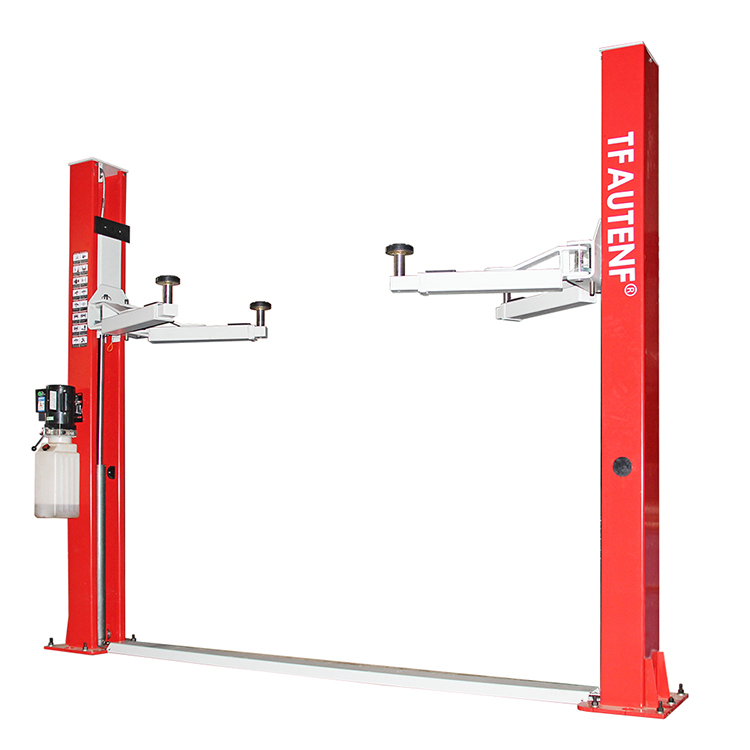
In the automobile maintenance industry,2 post car lift is one of the essential equipment. However, there are many brands on the market, and the quality is uneven, and many buyers step on the pit due to lack of experience. Today, we will reveal 5 secrets that manufacturers will not take the initiative to tell you, to help you avoid the trap when you buy 2 post car lift, buy a truly reliable product.
1. "National standard certification ≠ high quality", the key to look at the core parts
Many manufacturers will emphasize that their equipment "meets the national standard", but the national standard is only the minimum threshold, and what really determines the life of the lift is the quality of the core components, such as:
- Cylinder tightness: poor quality cylinders are prone to oil leakage, resulting in weak lifting or even sudden decline.
- Wire rope/chain material: Low strength wire rope is easy to break, there are safety risks.
- Motor and pump station: miscellaneous motor is easy to overheat and burn, affecting the service life.
✅ Pit avoidance advice:
- Priority is given to lift machines with hydraulic systems of well-known brands.
- Check whether the rope/chain is marked with breaking force (generally ≥3 times the rated load).
2. "Free installation" may hide secrets, be careful of subsequent charges
Many manufacturers under the banner of "free installation" to attract customers, but in fact:
- Hidden charges: such as "basic installation is free, but you need to pay additional commissioning fees, accessories fees".
- Non-standard installation: In order to save costs, some manufacturers send non-professionals to install, resulting in poor equipment stability.
✅ Pit avoidance advice:
- When signing the contract, it is clear whether to install, the scope of installation, and confirm whether commissioning, training and other services are included.
- Require the manufacturer to provide installation video or installation documents to ensure the standard operation.
3. "Long warranty period" but high maintenance costs, accessories are difficult to find
Some manufacturers advertise "5-year warranty", but the actual possibility is:
- Only some parts (e.g. frame, not hydraulic system) are guaranteed.
- Parts are expensive and difficult to find, resulting in long maintenance cycles and affecting business.
✅ Pit avoidance advice:
- Inquire about the warranty scope, focusing on the warranty policy of hydraulic system and motor.
- Select the market with high volume to ensure adequate supply of spare parts.
4. The "maximum lifting weight" may be falsely labeled, and the actual bearing capacity is insufficient
Some manufacturers marked "3.5 tons of lifting capacity" may be tested under ideal conditions, in actual use:
- When the center of gravity of the vehicle is shifted, the single side column may bear more pressure, resulting in unstable lifting.
- Long-term overload will accelerate equipment aging and even cause safety accidents.
✅ Pit avoidance advice:
- Select models with a rated load 20% higher than the actual demand (such as commonly used 3-ton vehicles, select 3.5-4 ton models).
- Manufacturers are required to provide third-party load-bearing test reports.
5. "Low price promotions" may be refurbished machines or inferior materials
Some lifts on the market have very low prices, which may be:
- Refurbishing machine: second-hand equipment is repainted, posing as new products.
- Inferior steel: the use of non-standard steel, long-term use is easy to deformation and cracking.
✅ Pit avoidance advice:
- Check whether the equipment has factory nameplate and verify the production date.
- Request material test report (e.g. Q235B steel is better than ordinary A3 steel).
Summary: How to choose a reliable double column lift?
1. Look at the core components: priority selected imported hydraulic system, high-strength steel wire rope/chain.
2. Ask for installation details: Avoid hidden charges and ensure professional installation.
3. Verify the warranty terms: focus on the warranty policy of key components such as hydraulics and motors.
4. Test the actual load bearing: choose a model slightly higher than the demand to avoid false labels.
5. Beware of ultra-low prices: Give priority to brands with high cost performance, relatively low prices and guaranteed quality, and avoid refurbished or inferior products.
